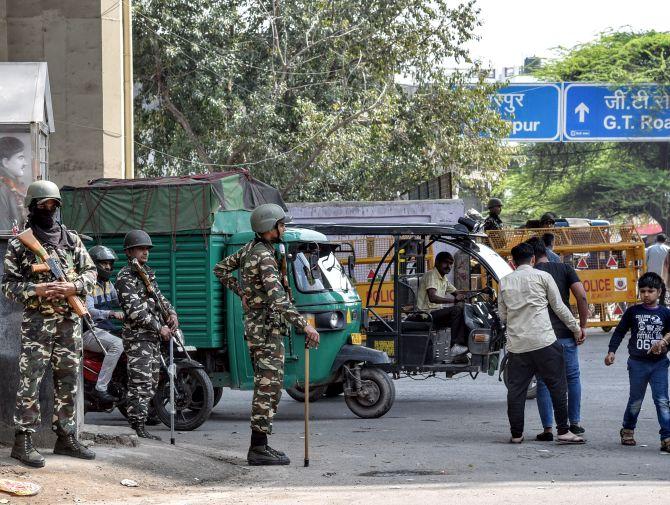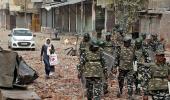'It wasn't as if the senior police inspectors in charge of the police stations were not aware of the communal tension that was being created in their areas before and during the riots.'
'Yet they chose not to act,' recalls Jyoti Punwani.

'Sometimes, there may be a flare-up when leaders are arrested. You know what happened in the Bombay riots... When shakha pramukhs were arrested, it flared up.' -- Chief Justice of India Sharad Arvind Bobde to Senior Advocate Colin Gonsalves who was asking that Kapil Mishra, whose hate speech sparked off the Delhi violence, be arrested.
When were shakha pramukhs arrested during any Bombay riot? Not in 1992-1993, not in the previous major riot in 1984.
In fact, again and again, through the hearings of the Justice B N Srikrishna Commission of Inquiry investigating the 1992-1993 riots, the police were asked why they had not arrested Shiv Sainiks inciting trouble in areas falling under their jurisdiction.
By not doing so, the Mumbai police were actually flouting the written orders of their then boss, Police Commissioner Shrikant Bapat.
On December 8, 1992, Bapat sent out a circular asking all police stations to arrest 'communal goondas and activists of the Shiv Sena, VHP and Bajrang Dal and influential goondas of the Shiv Sena'.
On December 10, 1992, he repeated those instructions and asked for a compliance report.
Police stations were supposed to maintain a list of communal goondas in their jurisdiction. Yet, not one of the above was arrested, the police told the Srikrishna Commission.
The reasons ranged from 'We didn't know what was meant by the term "communal goonda"' to 'We couldn't find a single person answering the description in our jurisdiction' to 'members of the Sena, VHP and Bajrang Dal were not troublemakers'.
The first circular was sent on December 8, 1992, the third day of the riots, by which time according to the Srikrishna Commission Report, 20 Hindus and 72 Muslims had been killed in police firing.
By the time the second circular was sent out, the number of Hindus shot in police firing had risen by 26, and Muslims by 43.
Yet, said the police, they couldn't find any 'communal goonda'.
This was in keeping with the police's laxity in the months preceding the riots when the VHP, helped by the Sena, organised programmes where inflammatory speeches were made exhorting the building of a Ram temple in place of the Babri Masjid. No one was arrested.
Even on December 6, 1992, despite the city being on high alert because of the goings-on in Ayodhya, the VHP organised ghanta nads (ringing of temple bells) in temples all over the city, to coincide with the so-called kar sewa at Ayodhya.
No action was taken.
All through the riots, the Sena put up boards with incendiary messages. At the very first maha aarti, a hate-filled leaflet was distributed, and subsequently, at every maha aarti, inflammatory speeches were made.
Maha aartis were the brainchild of the RSS, executed with Sena help. They were a novel method to get Hindus to gather on the roads outside temples. Despite intelligence reports that they would end in anti-Muslim violence, they were not stopped and no arrests were made.
Many of them did end with attacks on Muslims.
The Sena took out two rallies in December 1992; neither of them had police permission. Yet, no arrests were made either during or after the rallies.
The first was a victory rally taken out in Dharavi, north central Mumbai, just hours after the Babri Masjid was demolished. The slogans raised were so poisonous that they were not read out in court during the Srikrishna Commission's hearings. The rally led to the very first violent incident of the riots.
The second was a massive rally taken out by Sena leader Madhukar Sarpotdar in Bandra East, north west Mumbai, at the end of December, when stray incidents of violence were still taking place. Threatening slogans were raised and provocative placards displayed.
Sarpotdar and two other Shiv Sena leaders were convicted under Section 153 A -- promoting communal enmity -- for this rally in 2008, the first convictions in Mumbai of any Shiv Sainiks for hate speech.
All these activities before and after December 6, 1992, were brought on record before the Srikrishna Commission by the police themselves, for it was part of the constable's job to take note of any communally provocative activity.
So it wasn't as if the senior police inspectors in charge of the police stations were not aware of the communal tension that was being created in their areas before and during the riots.
Yet they chose not to act.
The reasons they gave for not arresting those indulging in such acts varied. While some said these activities were not objectionable and did not lead to communal tension, others said they could not locate the organisers of these activities.
But the commonest reason for not making any arrests while the riots were on was that arrests would have aggravated the situation.
This wasn't just the explanation given by inspectors who were close to Shiv Sainiks. One of them actually discussed the worsening situation in January 1993 with a Sena corporator, who told him 'not to worry'.
Head of the Special Branch I during the riots, Vasant Deshmukh, the only officer who described the Sena as a communal organisation prone to violence, told the Srikrishna Commission that the dominant view among senior police officers and bureaucrats was that preventive arrests of Shiv Sena leaders and activists would have resulted in flaring up unrest.
This view remained the same during the riots too, even after Sena leaders openly defied the police and indulged in riot offences. Even where victims named Shiv Sainiks as their assailants, the police did not arrest them.
Forget police officers and bureaucrats. then chief minister Sudhakar Naik himself gave the same reason -- the situation would flare up -- to a delegation of eminent citizens who asked him to order the arrest of Sena chief Bal Thackeray for his provocative writings in his party newspaper Saamna.
At one point, Justice Srikrishna asked the police whether by not arresting Shiv Sena leaders immediately wasn't a wrong signal being sent that they were immune from arrest?
The last two years of the Srikrishna Commission hearings were held when a Sena-BJP government was in power in Maharashtra, with Sena chief Bal Thackeray, the self-styled 'remote control' of the state. It was to a Sena-BJP government that the Srikrishna Commission's report was submitted in 1998, which said:
'Even after it became apparent that the leaders of the Shiv Sena were active in stoking the fires of communal riots, the police dragged their feet on the facile and exaggerated assumption that if such leaders were arrested the communal situation would further flare up, or to put it in the words of then CM, "Bombay would burn"; not that Bombay did not burn even otherwise.' (Srikrishna Commission Report, Volume I, Para 1.21)
These were the words of a sitting high court judge.
Today, the Chief Justice of India tells a lawyer that if leaders who make communal speeches are arrested even after a riot, the situation may flare up.
We've certainly come a long way.










